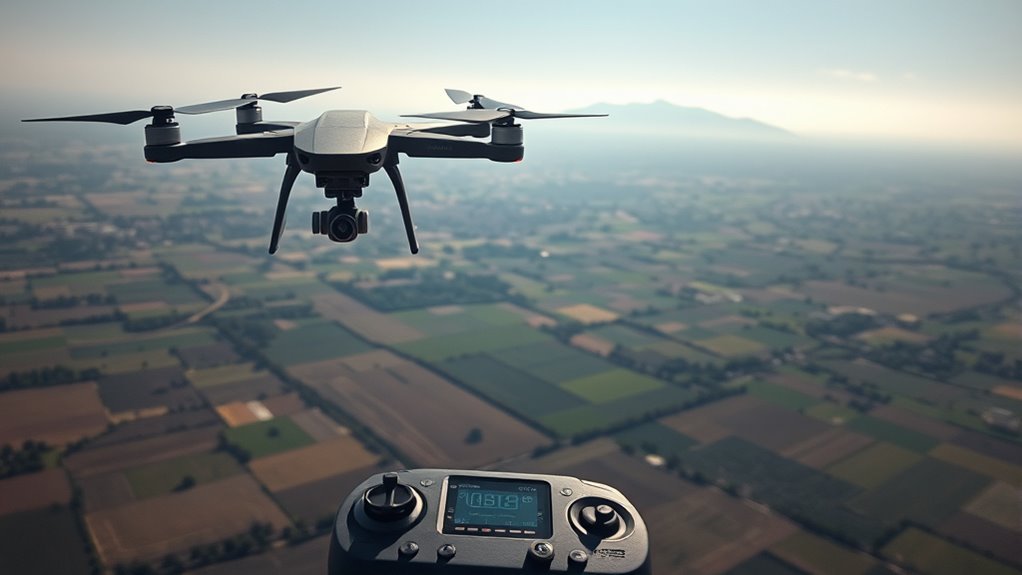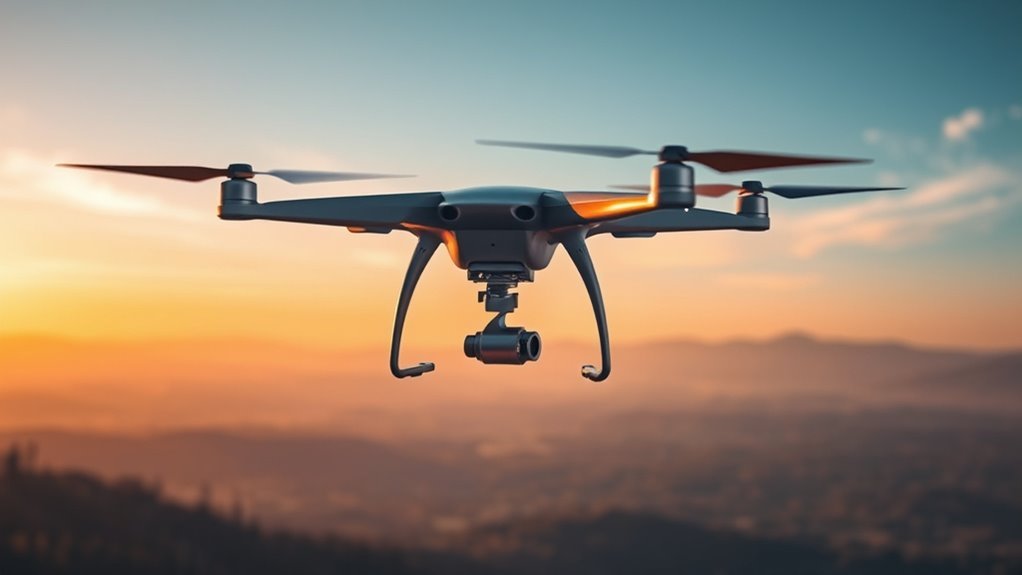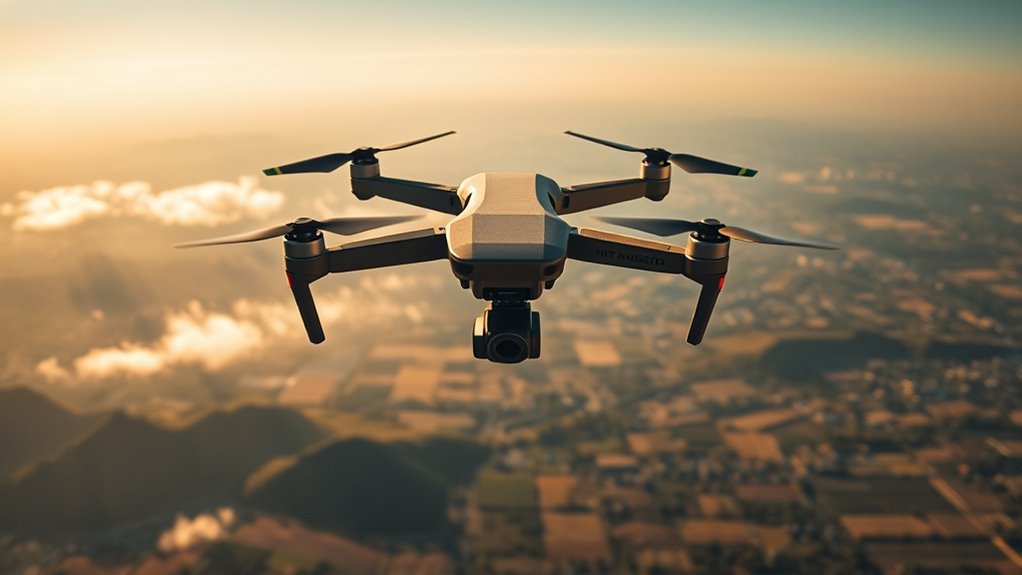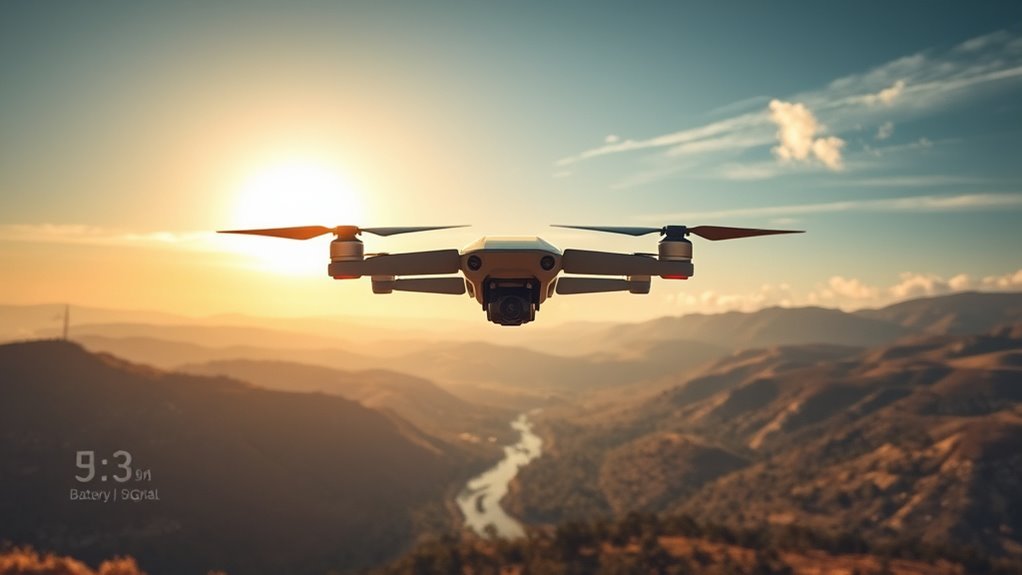Several factors affect how far your drone can go. Battery life and capacity are critical, as they dictate flight duration. The total weight and payload you carry influence energy consumption. Additionally, flight efficiency is impacted by aerodynamics and speed. Environmental conditions like temperature, wind, and humidity also play a significant role. Furthermore, controller range and signal strength are essential for maintaining communication. Understanding these factors can optimize your drone’s performance and enhance exploration capabilities.
Battery Life and Capacity

Battery life and capacity are critical determinants in evaluating how far a drone can travel. You’ll find that battery technology advancements have greatly influenced these factors. Modern lithium-polymer batteries, for example, provide notable energy density improvements, allowing for longer flight times without increasing weight. When you consider a drone’s range, it’s essential to analyze how efficiently it converts stored energy into flight time. Signal interference can also impact effective range and battery consumption during flight. Higher energy density means more power per unit weight, enabling you to explore farther and more freely than ever before. As these advancements continue, they’ll enhance your ability to undertake longer missions with fewer recharges, ultimately expanding your operational capabilities in a landscape where freedom to explore is paramount. Additionally, drones like the DJI Mavic 3 Thermal showcase impressive battery life, rated for up to 46 minutes under ideal conditions.
Weight and Payload

When considering a drone’s range, weight and payload play essential roles. The total weight directly impacts the drone’s ability to ascend and maintain stability during flight. If you overload your drone, you can expect a significant decrease in range due to increased energy consumption. To maximize performance, focus on payload optimization—selecting equipment that aligns with your drone’s capacity. Proper weight distribution is also important; unevenly distributed weight can lead to inefficient flight patterns and increased strain on motors. Consequently, it’s critical to balance your drone’s load effectively. By managing these factors, you’ll enhance your drone’s range, allowing for greater exploration and freedom in your aerial projects. Additionally, understanding battery capacity is essential for optimizing flight duration and overall range. The Dji Mini 2’s 4K video capabilities also benefit from a well-optimized payload, ensuring you capture high-quality footage during your flights.
Flight Speed and Efficiency

In evaluating flight speed and efficiency, you must consider how drone design influences aerodynamic performance. Factors like wind resistance and battery performance also play critical roles in determining the effective range. Understanding these elements can help optimize your drone’s operational capabilities. Additionally, battery life significantly impacts how far a drone can travel before needing a recharge. The aerodynamic design of the drone can greatly reduce air resistance, thereby enhancing overall flight efficiency.
Drone Design Impact
Although various factors influence drone performance, the design greatly impacts both flight speed and efficiency. Aerodynamic shapes reduce drag, allowing you to achieve higher speeds while conserving battery life. Material choice plays an essential role; lightweight yet durable materials enhance performance without compromising stability features. Design innovations can lead to improved weight distribution, ensuring balanced flight dynamics. Efficient propeller design contributes to thrust generation, maximizing your drone’s range. Frame construction influences structural integrity and overall weight, impacting how far you can fly. Finally, design aesthetics shouldn’t be overlooked; a visually appealing drone can inspire confidence and a sense of freedom in its operation. By carefully considering these elements, you can optimize your drone’s potential for distance.
Wind Resistance Effects
As drones navigate through varying wind conditions, their flight speed and efficiency can be greatly affected. Increased wind speed can lead to turbulence effects, which complicate flight stability. Understanding these factors is essential for maximizing your drone’s performance.
| Wind Speed (mph) | Flight Speed Impact | Efficiency Impact |
|---|---|---|
| 5 | Slight decrease | Negligible |
| 15 | Moderate decrease | Noticeable |
| 25 | Significant decrease | Severe |
In higher wind speeds, drones struggle to maintain a steady course, resulting in increased energy consumption and reduced range. By accounting for wind resistance effects, you can make informed decisions on flight paths, ensuring you harness the freedom of aerial exploration while minimizing potential setbacks.
Battery Performance Factors
Wind conditions can markedly influence drone performance, but battery performance is another key factor impacting flight distance. You’ll find that the type of battery chemistry used plays a vital role. Recent advancements in battery chemistry have led to significant energy density improvements, allowing drones to carry more power without increasing weight. This directly affects your drone’s flight speed and efficiency. Higher energy density means longer flight times and greater distances, which translates to more freedom in your aerial operations. Additionally, optimizing the drone’s speed to match its energy output can enhance overall performance, ensuring you get the most out of each flight. By understanding these battery performance factors, you can maximize your drone’s capabilities and extend its range effectively.
Environmental Factors
When considering how environmental factors influence drone distance, you must take into account variables like temperature, humidity, and air pressure. Weather conditions can greatly impact your drone’s performance. For instance, high temperatures can reduce battery efficiency, leading to shorter flight times. Similarly, humidity affects the drone’s lift, as moist air is less dense than dry air. This can result in increased energy consumption and diminished range. Additionally, high air pressure can improve lift and efficiency, while low pressure may hinder them. Understanding these temperature effects and their interplay with weather conditions allows you to better plan your flights, maximizing your drone’s potential. Knowledge of these factors guarantees you can navigate the skies with greater freedom and confidence.
Controller Range and Signal Strength
When operating your drone, the controller’s range and signal strength are critical factors that directly affect its operational distance. You’ll need to contemplate how signal frequency impacts transmission quality, the efficiency of antenna design, and the potential interference caused by obstacles in the environment. Understanding these elements will help you optimize your drone’s performance and extend its range.
Signal Frequency Impact
Although many factors influence a drone’s operational distance, the signal frequency plays an essential role in determining both controller range and signal strength. Higher frequency signals can provide greater bandwidth, allowing for more data transmission, which is critical for real-time video feeds and telemetry. However, these signals are more susceptible to signal interference from physical obstacles and atmospheric conditions. Conversely, lower frequency signals penetrate obstacles better, but they can suffer from lower data rates. Frequency modulation techniques can help mitigate interference, enhancing signal clarity. By understanding how these frequencies interact, you can optimize your drone’s performance, ensuring reliable communication over longer distances while maintaining the freedom to explore vast areas without losing control.
Antenna Design Efficiency
Antenna design greatly influences a drone’s controller range and signal strength. The choice of antenna materials and the effectiveness of signal polarization directly impact how well your drone communicates with its controller.
Consider these factors:
- Material Quality: High-quality materials enhance durability and signal transmission.
- Polarization: Proper alignment of signal polarization minimizes interference and optimizes communication.
- Antenna Shape: The design shape can affect the directionality and range of the signal.
Obstacle Interference Effects
Obstacle interference plays a critical role in determining the effective range and signal strength of your drone’s communication system. When flying, you’ll encounter various obstacles that can disrupt signal transmission, including buildings, trees, and hills. Effective obstacle detection systems are essential for maintaining control and ensuring safe terrain navigation. These systems help your drone adapt its flight path, minimizing signal loss while maneuvering through complex environments. However, dense or reflective surfaces can still degrade signal integrity, leading to reduced controller range. Understanding these limitations allows you to plan your flights better and optimize your drone’s performance. By accounting for potential obstacles in your flight path, you can enhance your drone’s operational efficiency and maintain a reliable connection with your controller.
Drone Design and Aerodynamics
When considering the distance a drone can travel, its design and aerodynamics play crucial roles. The choice of drone materials and the specific airfoil shapes directly influence performance, stability, and efficiency. Here are some key design factors to keep in mind:
- Lightweight materials: Using advanced composites can reduce weight, enhancing flight range. Drones with optimized battery technology can also significantly improve overall flight endurance.
- Optimized airfoil shapes: Aerodynamically efficient designs minimize drag, allowing for smoother airflow.
- Propulsion system design: Effective motor and propeller combinations guarantee maximum thrust and energy utilization. Additionally, drones like the Wingtra One exhibit superior endurance due to their advanced battery technology, which enhances overall performance.
Regulatory Restrictions and Limitations
While many enthusiasts are enthusiastic to push the limits of drone technology, regulatory restrictions and limitations considerably impact how far a drone can operate. You’ll need to navigate various regulatory compliance measures, which dictate where and how high you can fly. Airspace restrictions can limit your operational range, especially near airports or populated areas. Additionally, safety regulations often require you to maintain visual line-of-sight with your drone, further constraining distance. Drones must be operated within line-of-sight and obtaining flight permissions is essential for flying in restricted zones, but this can be a time-consuming process. By understanding and adhering to these regulations, you can better plan your flights, balancing your desire for freedom with the necessary legal frameworks that guarantee safety in the skies. Furthermore, federal government controls navigable airspace above personal property, which adds another layer of complexity to drone operations.
Frequently Asked Questions
How Does the Type of Drone Affect Its Range?
Imagine a futuristic hovercraft; drone type markedly impacts range. Heavier drones generally have lower battery capacity, limiting distance. Lighter models with efficient batteries often achieve greater ranges, granting you more freedom in exploration and application.
Can Terrain Impact a Drone’s Flight Distance?
Yes, terrain types greatly impact a drone’s flight distance. For instance, flying at high altitudes or over rugged landscapes can reduce battery efficiency, limiting range due to increased energy consumption and potential signal interference.
What Role Does Maintenance Play in Drone Performance?
Did you know 30% of drone failures stem from poor maintenance? Regular drone upkeep guarantees peak battery health, directly impacting flight performance and distance. Neglecting maintenance can severely limit your drone’s capabilities and freedom in the sky.
Are There Different Ranges for Various Drone Models?
Yes, different drone models have varying ranges, primarily influenced by their specifications and battery capacity. Higher specifications typically allow for greater distances, while larger battery capacities enhance flight time and range, granting you more operational freedom.
How Does Weather Influence Drone Flight Distance?
Oh sure, your drone loves a challenge! But wind conditions and humidity levels can seriously cramp its style. High winds can push it off course, while humidity may affect battery performance, limiting your aerial adventures.

